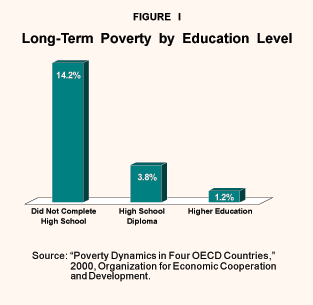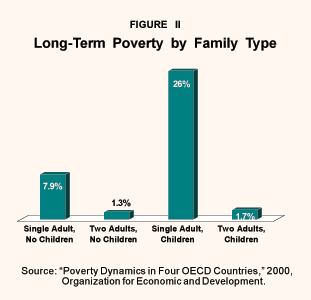About 31 million Americans live in households with incomes below the poverty level, according to the latest U.S. Census data. Poverty is more than a lack of income. It is also the consequence of specific behaviors and decisions. The 2001 Census data clearly show that dropping out of high school, staying single, having children without a spouse, working only part time or not working at all substantially increase the chances of long-term poverty. Certain behaviors are a recipe for success. Among those who finish high school, get married, have children only within a marriage and go to work, the odds of long-term poverty are virtually nil.
Stay in School.
Simply completing high school greatly increases a person's chances of not being poor. [SeeFigure I.] The Census Bureau reports that:
- Only 9.6 percent of high school graduates are poor, compared to 22.2 percent of those without a diploma.
- Of those people who complete some college, only 6.6 percent fall below the poverty line.
- This drops to 3.3 percent of those with a bachelor's degree or higher.
Furthermore, these lower propensities for poverty last throughout a person's life. In every adult age group, people who fail to obtain a high school degree are more than twice as likely to fall into poverty. People ages 25 to 54 are nearly three times as likely.
The numbers are worse for long-term poverty – poverty that lasts for years. An Organization for Economic Cooperation and Development (OECD) report found that in the United States:
- High school dropouts suffer a long-term poverty rate of 14.2 percent, while high school grads have only a 3.8 percent long-term poverty rate.
- Only 1.2 percent of adults receiving some education beyond high school are poor long-term.
Get a Job.
Despite concerns about the working poor, most people who work full time, even at minimum wage jobs, avoid poverty:
- Only 2.6 percent of people 16 years or older with full time jobs are poor, according to Census data.
- By contrast, 11.4 percent of part-time workers fall under the poverty line, and 20.8 percent of those who do not work fall below the poverty line.
The advantages of work hold true even for at-risk groups, such as single mothers:
- About 83 percent of single mothers who do not work are in poverty, compared to nearly 60 percent who work part time.
- But less than 18 percent of single mothers who work full time are in poverty.
Working also significantly reduces long-term poverty. According to an analysis of the Census Bureau's Survey of Income and Program Participation, 10.8 percent of adults who do not work are poor over the long term. In contrast, only 1.7 percent of those employed part time stay poor for extended periods. People employed full time have a 0.4 percent chance of long-term poverty.
Moreover, the government can encourage behavioral changes. Research shows that between one-third and one-half of the fall in poverty among single mothers on welfare after 1994 was due to the 1996 welfare reforms that encouraged work.
Get Married.
Marriage is also a strong deterrent to poverty. [See Figure II.]
- Only 4.0 percent of married couples without children are in poverty, according to Census data.
- In contrast, the poverty rate for singles without children is 8.6 percent.
Moreover, married couples are less likely to experience long-term poverty. According to the OECD report:
- Married couples without children have a long-term poverty rate of only 1.3 percent.
- By contrast, 7.9 percent of single adults experience long-term poverty.
Marriage promotes economic advancement. One study found that married men earn 22 percent more than their unmarried counterparts. The OECD reports that a woman head of household who marries increases her chances of exiting poverty by 23 percent. A single person who marries and finds employment increases his or her chances of leaving poverty by over 50 percentage points.
Don't Have Children Out of Wedlock.
Having children outside of marriage is costly for both the individual and the child. The Census Bureau reports:
- Of those households with two or more children under the age of 18, 7.9 percent of married households were poor, while 51.6 percent of never-married households were poor.
- Of those households with two or more children under the age of 6, 11.5 percent of married households were poor, while 62.4 percent of never-married households were poor.
According to the OECD study, spells of poverty are 12.6 percent shorter for married households compared to female-headed households. Similarly, married households with children are much more likely to avoid long-term poverty than single parent households. Only 1.7 percent of married households with children suffer long-term poverty, while 26 percent of single parent households are poor long term.
Child poverty is dependent on the behavior of parents. Using data from the National Longitudinal Survey of Youth, a Heritage Foundation study finds:
- On average, a child raised by a never-married mother is 9 times more likely to live in poverty than a child raised by two parents in an intact marriage.
- Nearly 80 percent of children in long-term poverty live in some type of broken family or with a never-married parent.
- Children born to parents who do not marry spend, on average, 56.7 percent of their lives in poverty as opposed to just 6.3 percent for children in married families.
Conclusion
Poverty is most often a consequence of specific behavior. By engaging in other behaviors, people can avoid poverty. To help people escape poverty, government programs should encourage these behaviors. The 1996 welfare reforms encouraged work – and the rate of poverty fell. Proposals to encourage marriage, like President Bush's plan to eliminate the marriage penalty, could have similar benefits.
Blake Bailey is an intern with the National Center for Policy Analysis.